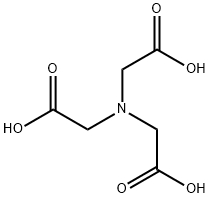Nitrilotriacetic acid:Uses,Toxicity and Carcinogenicity
Nitrilotriacetic acid (NTA) is an odorless white solid, sinks in and mixes with water. It is used as a binder in detergents, a chelating agent for soaps,in thepurification of rare-earth elements, and in water treatment.
Uses
Nitrilotriacetic acid (NTA) has the ability to link with histidine side chain of proteins. It can be used in fluorescent labelling, hexahistidine (His6)-tagged proteins for purification and surface immobilization.
Reproductive toxicity, embryotoxicity, and teratogenicity
NTA may be beneficial in neonatal development because it increases the bioavailability of essential elements. NTA was not teratogenic or embryotoxic in studies with mice (0.2% NTA), rats (0.1 or 0.5% trisodium salt) , or rabbits (250 mg of trisodium salt per kg of body weight). Mutagenicity and related end-points The mutagenic and clastogenic potential of NTA has been investigated both in vivo and in vitro, but the results of the assays conducted to date have been largely negative. It enhances the induction of sister chromatid exchange in Chinese hamster cells by insoluble salts of some heavy metals, and some insoluble salts of chromium(VI) are mutagenic in the Salmonella microsome assay in the presence of NTA.
Carcinogenicity
There was no evidence of carcinogenicity in studies in which weanling Charles River CD rats were fed diets containing 0.03, 0.15, or 0.5% of the trisodium salt or 0.5% of the calcium chelate of NTA for 2 years, groups of 80 Swiss mice were given drinking-water containing 5 g of NTA per litre or 5 g of NTA plus 1 g of sodium nitrite per litre for 26 weeks, or groups of 15 male and 15 female MRC rats were exposed to the same levels for 84 weeks.
Incompatibilities
Dust may form explosive mixture with air. Compounds of the carboxyl group react with all bases, both inorganic and organic (i.e., amines) releasing substantial heat, water and a salt that may be harmful. Incompatible with arsenic compounds (releases hydrogen cyanide gas), diazo compounds, dithiocarbamates, isocyanates, mercaptans, nitrides, and sulfides (releasing heat, toxic and possibly flammable gases), thiosulfates and dithionites (releasing hydrogen sulfate and oxides of sulfur). Attacks aluminum, copper, copper alloy and nickel.
See also
Lastest Price from Nitrilotriacetic acid manufacturers

US $50.00-10.00/kg2025-07-17
- CAS:
- 139-13-9
- Min. Order:
- 1kg
- Purity:
- 99%,Electronic grade(Single metal impurity≤ 100ppb)
- Supply Ability:
- 200kg
US $1.00/kg2025-04-21
- CAS:
- 139-13-9
- Min. Order:
- 1kg
- Purity:
- 99%
- Supply Ability:
- 10 mt


